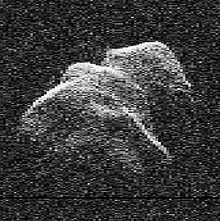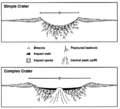
Plot of orbits of known Potentially Hazardous Asteroids (size over 460 feet (140 m) and passing within 4.7 million miles (7.6×10^6 km) of Earth's orbit) as of early 2013
A potentially hazardous object (PHO) is a near-Earth asteroid or comet with an orbit such that it has the potential to make close approaches to the Earth and is of a size large enough to cause significant regional damage in the event of impact.
Overview
An object is considered a PHO[1] if its minimum orbit intersection distance (MOID) with respect to Earth is less than 0.05 AU (7,500,000 km; 4,600,000 mi) (approximately 19.5 lunar distances) and its diameter is at least 100 to 150 meters (330-500 ft). This is big enough to cause regional devastation to human settlements unprecedented in human history in the case of a land impact, or a major tsunami in the case of an ocean impact. Such impact events occur on average around once per 10,000 years. NEOWISE data estimates that there are 4,700 ± 1,500 potentially hazardous asteroids with a diameter greater than 100 meters.[2] As of 2012, an estimated 20 to 30 percent of these objects have been found.[2] Asteroids larger than 35 meters across can pose a threat to a town or city.[3]
The diameter of most small asteroids is not well known and can only be estimated based on their brightness and distance. For this reason NASA and the Jet Propulsion Laboratory use the more practical measure of absolute magnitude (H). Any asteroid with an absolute magnitude of 22.0 or brighter is assumed to be of the required size,[4][5] although only a coarse estimation of size can be found from the object's magnitude because an assumption must be made for its albedo which is also not usually known for certain. The NASA near-Earth object program uses an assumed albedo of 0.13 for this purpose.[4]
By January 2009, NASA had listed 1006 potentially hazardous asteroids (PHAs) and 85 near-Earth comets (NECs).[6] The total Solar System inventory continues to grow, with 1360 PHA known as of December 2012.[4][7] Projects such as Lincoln Near-Earth Asteroid Research and Catalina Sky Survey continue to search for more PHOs. Each one found is studied by various means, including optical, radar, and infrared to determine its characteristics, such as size, composition, rotation state, and to more accurately determine its orbit. Both professional and amateur astronomers participate in such monitoring.
During an asteroid's close approaches to planets or moons it will be subject to gravitational perturbation, modifying its orbit, and potentially changing a previously non-threatening asteroid into a PHA or vice versa. This is a reflection of the dynamic character of the Solar System.
The two main scales used to categorize the impact hazards of asteroids are the Palermo Technical Impact Hazard Scale and the Torino Scale.
Largest PHA
The largest PHA (based on absolute magnitude H) discovered in a given year:[8]
See also
References
External links
|
|---|
| | | | | | | | | | | | | | | | |
-
 PORTALS: Astronomy PORTALS: Astronomy
- Earth sciences
- Solar System
|
|
|
|---|
| | Pre–2000 | | |
|---|
| | Post–2000 | |
|---|
| | Jupiter | |
|---|
| | Lists | |
|---|
| | See also | |
|---|
|
|
|---|
| | Lists | | |
|---|
| Confirmed
≥20 km diameter | |
|---|
| | Topics | |
|---|
| | Research | |
|---|
|
Planetary defense |
|---|
| | Main topics | | |
|---|
| | Defense | |
|---|
| | Space probes | |
|---|
| | NEO tracking | |
|---|
| | Organizations | |
|---|
| | Potential threats | |
|---|
|




